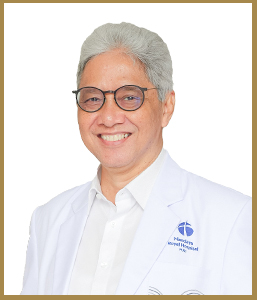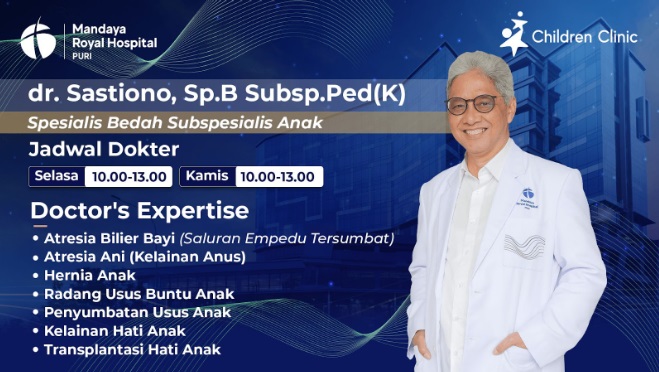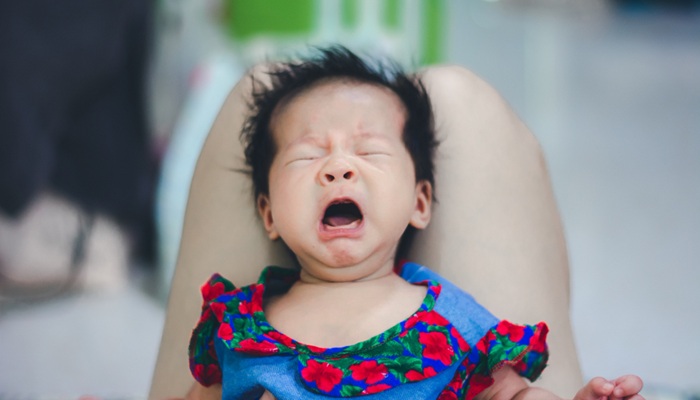Inguinal hernia in babies occurs when abdominal tissue, such as fat or a portion of the intestine, presses through a gap in the lower abdominal wall—the area that separates the abdomen and groin.
This type of hernia develops in the inguinal canal, a passage located on both sides of the pelvis leading to the reproductive organs. Because of its location, the condition is also commonly known as a groin hernia (inguinal means “in the groin”).
Mandaya Royal Hospital Puri has a team of highly skilled pediatric surgeons experienced in handling inguinal hernias in infants, including dr. Sastiono, Sp.B Subsp.Ped(K), who not only specializes in this field but also has extensive experience treating complex conditions in newborns and children.
Contents
Symptoms of Inguinal Hernia in Babies
The main symptom of inguinal hernia in babies is a visible lump under the skin in the groin area or scrotum (the sac that holds the testicles). This lump usually becomes more noticeable when the baby cries or strains and may shrink or disappear when the baby is relaxed or asleep. The lump can appear on one side or both sides of the groin.
Other symptoms may include:
- Pain or discomfort that improves with rest
- A feeling of heaviness or pressure in the groin
- Swelling of the scrotum
- A warm or burning sensation in the affected area
- Fussiness and feeding difficulties
What Causes Inguinal Hernia in Babies?
All babies are born with a small tunnel-shaped passage called the inguinal canal, which runs from the abdomen down to the genital area. During fetal development, a baby boy’s testicles form in the abdomen and then move down through the inguinal canal into the scrotum.
Normally, this canal closes before birth. However, in some cases, it doesn’t close completely, leaving an opening between the abdomen and the inguinal canal. This gap allows a portion of the intestine to push through, causing a hernia.
Although less common, inguinal hernias can also occur in baby girls. Girls also have an inguinal canal, and in rare cases, the hernia may contain part of the reproductive organs, such as an ovary.
How Do Doctors Diagnose Inguinal Hernia in Babies?
Doctors can usually diagnose inguinal hernia through a physical examination. They will look for a bulge in the groin or scrotum while the baby is crying or straining, and observe if the bulge disappears when the baby is relaxed.
If the baby is old enough, the doctor may ask them to stand or cough to see if the bulge appears. The doctor may also gently massage the hernia area to return the protruding tissue to its proper place. In certain cases, additional imaging tests such as ultrasound (USG) may be recommended to confirm the diagnosis.
How Is Inguinal Hernia in Babies Treated?
Inguinal hernia in babies is typically treated through surgery. The general steps include:
-
Before the Surgery
An anesthesiologist will administer general anesthesia to keep the baby relaxed and asleep throughout the procedure, ensuring no pain is felt during the operation.
-
During the Surgery
The pediatric surgeon will make a small incision in the baby’s groin area. Through this incision, the surgeon will push the protruding tissue back into the abdominal cavity and close the opening in the inguinal canal to prevent recurrence. The incision is then closed with special adhesive strips for faster healing.
-
After the Surgery
Most babies can go home just a few hours after the procedure. However, if the baby was born prematurely or has other medical conditions, the doctor may recommend overnight observation in the hospital.
Treatment of Inguinal Hernia in Babies at Mandaya Royal Hospital Puri

The treatment of inguinal hernia in babies at Mandaya Royal Hospital Puri is performed by an experienced pediatric surgeon, dr. Sastiono, Sp.B Subsp.Ped(K).
Dr. Sastiono has special expertise in hepatobiliary surgery, which includes operations on the liver, gallbladder, bile ducts, and pancreas. He is also recognized as one of Indonesia’s few pediatric surgeons qualified to perform liver transplants in children.
In addition to treating hernia cases, Dr. Sastiono has extensive experience performing various pediatric surgical procedures, including:
- Biliary atresia (bile duct obstruction in infants)
- Anorectal malformations (atresia ani)
- Hirschsprung’s disease
- Appendicitis in children
- Intestinal obstruction
- Various liver disorders in children.

Clinic schedule:
- Tuesday: 10:00 AM – 1:00 PM
- Thursday: 10:00 AM – 1:00 PM
For an easier visit to Mandaya Royal Hospital Puri, you can use the Chat via WhatsApp, Book Appointment, or the Care Dokter app, available on Google Play and App Store, to check queue numbers and access complete hospital information conveniently.



